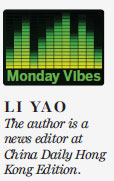Rebound in mainland tourists precious for HK
Updated: 2016-08-22 07:38
By Li Yao(HK Edition)
|
|||||||
The rebound of Chinese mainland tourist arrivals in July after 12 months of declines is heartening. The hospitality sector in Hong Kong may breathe a sigh of relief about the 2.2-percent year-on-year increase of inbound mainland tourist numbers in July - minuscule progress that gives rise to the hope that the worst may be over.
There are obvious, external reasons to explain the upswing. To list just a few: It is school summer break, a usual peak time for vacation-goers; a rising yen makes Japan less affordable; and the terrorist attacks striking European cities have made people hesitant about traveling there for safety reasons.

But relying on external factors has unpredictable outcomes. The changes from within, which drove this improvement, demand a clearer understanding. They lay the foundation for sustained, healthy development of the tourism industry.
With the city's hospitable image losing its sheen, multi-pronged measures have been taken in earnest to win back tourists' trust, with promises of quality services, unique travel experiences, new attractions, and a low tolerance of malpractices.
And looking introspectively at what worked and what failed should also lead to a better appreciation of the industry's ecosystem. The turbulence the local market experienced in the past year laid bare its vulnerability to unethical mainland travel agencies operating in Hong Kong. The influx of mainland tourists, like music to the tourism sector's ears, was perceived by some local residents as coming in excessive numbers which surpassed the city's capacity. This contributed to parallel trading that inconvenienced their daily lives. Ill will and hostility from some corners of society was enough to sink mainland visitors' enthusiasm and in turn the city's tourism industry took a hit.
Low-priced or even zero-cost tours in Hong Kong used to be common and caused many innocuous mainland tourists to suffer abuse from tour guides, who pressed them to spend more at arranged luxury stores so the guides received handsome commissions. This malaise of the industry culminated in a deadly attack on a mainland tourist when an altercation developed over a tourist not complying with the suggested shopping spree in Hung Hom last October.
Such tours seem to have abated lately, thanks to a concerted crackdown since mid-July by the Hong Kong Tourism Board and Shenzhen tourism authorities. An official list of estimated, reasonable prices of group tours to Hong Kong has been released for the third quarter, from a one-day trip that is likely to cost 198 yuan ($30) covering two meals and transport, to 1,526 yuan for a four-day tour in Hong Kong and Macao including visits to Ocean Park and Hong Kong Disneyland. For those unaware of this, the full price list displayed on a giant poster inside the Shenzhen Bay boundary crossing is hard to miss when they approach the Hong Kong customs and immigration clearance to enter the SAR. I noticed the fresh poster during a recent return trip to Hong Kong.
Single-mindedly pursuing high numbers of tourist arrivals at the expense of local residents' goodwill backfired. An isolated approach to address the local tourism market woes by the city itself is deficient. The tourism sector has the best chance of thriving under a holistic strategy that seeks to strengthen its core competitiveness, while aligning the acts and interests of important stakeholders for sustainable growth.
(HK Edition 08/22/2016 page10)